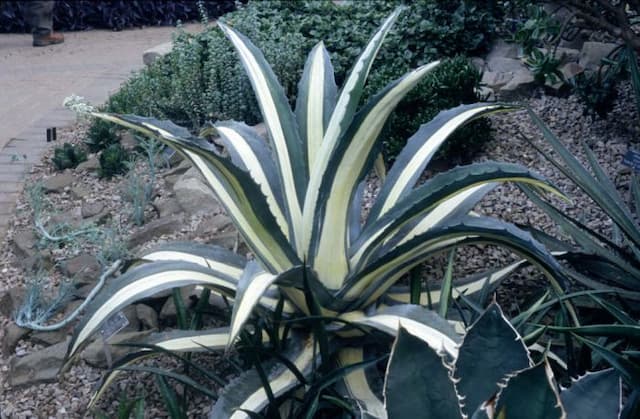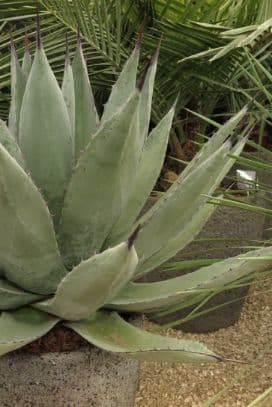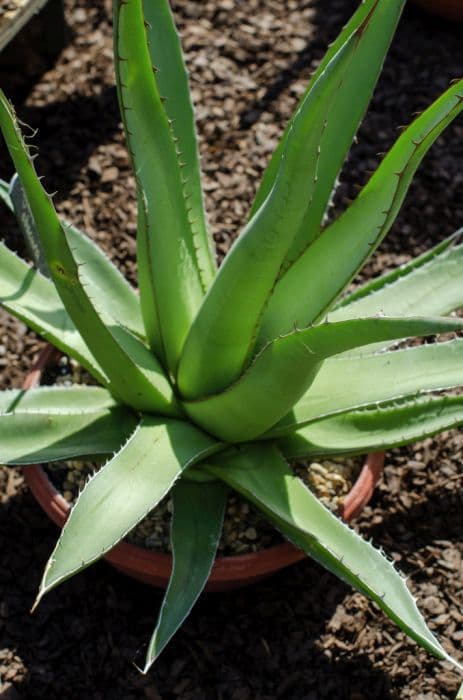Grape hyacinth 'Touch of Snow' Muscari armeniacum 'Touch of Snow'

ABOUT
'Touch of Snow' is a deciduous, bulbous perennial, to 20cm in height, with green, strap-like leaves and dense flower spikes, mid-blue with white tips to the petal edges in spring. Flowers initially open from green buds and flower spike tips appear white before darkening to mid-blue
About this plant
 Names
NamesFamily
Asparagaceae.
Synonyms
Armenian Grape Hyacinth, Garden Grape Hyacinth, Touch of Snow.
Common names
Muscari armeniacum 'Touch of Snow'.
 Characteristics
CharacteristicsLife cycle
Perennials
Foliage type
Deciduous
Color of leaves
Green
Flower color
Blue
Height
6 inches (15 cm)
Spread
3 inches (8 cm)
Plant type
Bulb
Hardiness zones
4
Native area
Eurasia
Benefits
 General Benefits
General Benefits- Easy to Grow: The plant is known for being low-maintenance and easy to care for, making it suitable for gardeners of all skill levels.
- Aesthetic Appeal: With its unique 'Touch of Snow' white-tipped blue flowers, it adds visual interest and beauty to gardens.
- Attracts Pollinators: The flowers of Muscari, commonly known as Grape Hyacinth, attract bees and other pollinators, supporting local ecosystems.
- Drought-Tolerant: Once established, Grape Hyacinth is quite tolerant of drought, making it a good choice for water-wise gardens.
- Naturalizing: It can spread over time, creating a natural, self-sustaining display without much human intervention.
- Deer and Rodent Resistant: Grape Hyacinth is typically resistant to deer and rodents, which can help protect other more vulnerable plants in the garden.
- Spring Bloomer: Blooming in early spring, Grape Hyacinth offers an early burst of color after a long winter.
- Multiplication: The bulbs can multiply, so you can propagate more plants over time for an expanded display or to share with others.
- Compact Size: Its small stature makes it perfect for container gardens or small spaces where other plants might be too large.
- Versatility: Grape Hyacinth can be planted in borders, rock gardens, under trees or in grass for a variety of landscaping designs.
 Medical Properties
Medical PropertiesThis plant is not used for medical purposes.
 Air-purifying Qualities
Air-purifying QualitiesThis plant is not specifically known for air purifying qualities.
 Other Uses
Other Uses- Muscari armeniacum 'Touch of Snow', commonly known as Grape Hyacinth, can be used in crafting potpourri as its dried flowers retain some fragrance and add a touch of color.
- The sturdy stems of Grape Hyacinth can be woven into small, decorative wreaths for tabletops during spring celebrations.
- These plants can be used in photography as objects in macro photography to showcase intricate details that are often not seen by the naked eye.
- Grape Hyacinth can be used in educational settings, such as schools or botanical gardens, to illustrate bulb growth and plant cycles to students.
- Due to their distinctive shape, Grape Hyacinths can inspire artists and be used as subjects in botanical illustration and watercolor painting classes.
- The cobalt blue of the Grape Hyacinth can be utilized by textile designers as a natural source for color inspiration in fabric design.
- Fine dining restaurants may use the blooms of the Grape Hyacinth as an elegant, non-toxic garnish on plates for a splash of color.
- Grape Hyacinth can be planted amongst vegetables in a kitchen garden to provide a burst of color and to potentially deter certain pests with its strong scent.
- The bulbs of Grape Hyacinth can be used in experiments on vegetative reproduction and bulb propagation in horticultural studies.
- Grape Hyacinth are suitable for creating a "living mulch" in orchards or garden beds, where their dense growth can help suppress weeds.
Interesting Facts
 Feng Shui
Feng ShuiGrape hyacinth is not used in Feng Shui practice.
 Zodiac Sign Compitability
Zodiac Sign CompitabilityGrape hyacinth is not used in astrology practice.
 Plant Symbolism
Plant Symbolism- Perseverance: As a harbinger of spring, the grape hyacinth often pushes through the last snows of winter, symbolizing determination and the ability to overcome challenges.
- Trust: The sturdy and reliable blooming of grape hyacinth each year represents trust and constancy in relationships.
- Optimism: With its bright and playful appearance, this plant signifies hope and the expectation of joy and happiness.
- Beauty: The delicate and intricate blossoms of grape hyacinth are often associated with the beauty of nature and appreciation for the detailed aspects of life.
 Water
WaterGrape hyacinths, including 'Touch of Snow', prefer to be watered thoroughly when the soil is dry to the touch, which typically means once a week during their active growing season in spring. Once the foliage begins to die back after flowering, gradually reduce watering. Water with about one gallon per square foot every time you water to ensure the soil is moist but not waterlogged. During dormant periods, especially in summer when the bulbs are resting, watering should be very minimal or not at all to prevent bulb rot.
 Light
LightGrape hyacinths like 'Touch of Snow' thrive in full sun to partial shade. The ideal spot for them would be in a location where they can enjoy morning sunlight and some afternoon shade, especially in hotter climates. They can also grow well in dappled light, like that under a deciduous tree, where they receive filtered sunlight throughout the day.
 Temperature
TemperatureGrape hyacinths, such as 'Touch of Snow', are tolerant of a wide range of temperatures but perform best in cooler climates. They can survive winter cold down to about 25 degrees Fahrenheit, and during their growth period in spring, they prefer temperatures between 50 and 75 degrees Fahrenheit. Extreme heat can be detrimental and may require the plant to be shaded or watered more frequently to maintain adequate moisture.
 Pruning
PruningPruning grape hyacinths, such as 'Touch of Snow', is mainly about removing spent flower stalks after blooming to maintain a tidy appearance and prevent self-seeding if desired. It is not necessary to prune the foliage until it has yellowed and died down naturally, as the leaves are essential for photosynthesis to replenish the bulbs for the next season. Prune the foliage only when it has fully withered, usually a few weeks after flowering.
 Cleaning
CleaningAs needed
 Soil
SoilGrape Hyacinth 'Touch of Snow' thrives in well-draining soil, with a preferred pH of 6.0-7.0. The best soil mix combines garden soil, compost, and sand to enhance drainage. Adding a bit of bone meal can encourage robust bulb development.
 Repotting
RepottingGrape Hyacinth 'Touch of Snow' typically does not need frequent repotting. Repotting every 3-5 years is sufficient, or when the bulbs multiply and become overcrowded in their current container.
 Humidity & Misting
Humidity & MistingGrape Hyacinth 'Touch of Snow' is tolerant of most humidity levels and does not require special humidity conditions. It grows well in the average humidity found in a typical outdoor garden setting.
 Suitable locations
Suitable locationsIndoor
Ensure bright light, cool temps, and good air flow for indoor Grape Hyacinth.
Outdoor
Plant in partial shade or full sun and well-drained soil outdoors.
Hardiness zone
3-9 USDA
 Life cycle
Life cycleMuscari armeniacum 'Touch of Snow', commonly known as Grape Hyacinth 'Touch of Snow', begins its life cycle with bulb formation, where the plant stores its energy underground. In the early spring, it germinates and produces narrow, green leaves followed by stems that bear the distinctive blue and white flowers which give it the 'Touch of Snow' appearance. After flowering, the plant undergoes pollination, often with the help of bees and other insects, leading to seed production. Once the seeds are mature, they are dispersed to the surrounding area, potentially creating new plants. During the summer months, the foliage dies back, and the plant enters dormancy, conserving energy within the bulb. With the arrival of the next spring, the cycle begins anew as the bulb awakens to start the growth process over again.
 Propogation
PropogationPropogation time
Early Spring
Propogation: The best time to propagate Grape Hyacinth 'Touch of Snow' is in late summer after the leaves have died back, or in the fall before the ground freezes. The most popular method involves division, where clusters of bulbs, known as 'offsets' or 'bulbils', that form around the base of the parent plant are gently separated and replanted. This is best done every few years to prevent overcrowding. To propagate, carefully lift the clump of bulbs with a garden fork, ensuring not to damage the bulbs. Gently pull apart the individual offsets, and plant them immediately at a depth of about 3 inches (approximately 7.6 centimeters) and spaced about 3 inches apart to give them enough room to grow and mature. This method is simple and effective, ensuring genetic consistency within the new plants.









